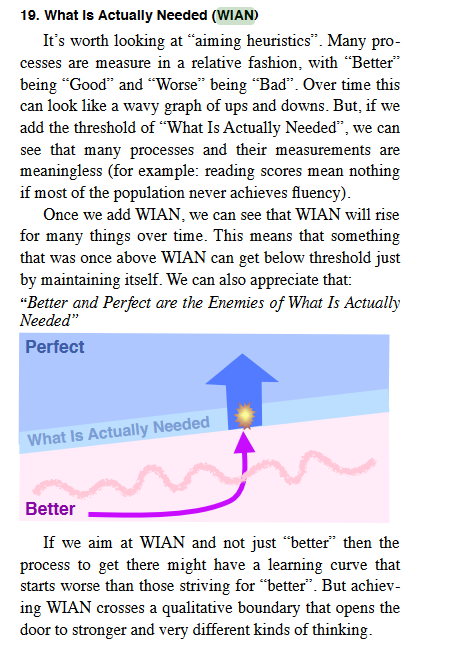Late last year I was accidentally introduced to the world of Xerox PARC by some people I follow on Twitter and ever since then there has not been a single day that has gone by without me pondering about the state of computers, programming, and the structural elements associated with it, whether it is about software development or the patterns that we consider to be the holy grail of computer science. This is to say that there have been a lot of movements in the field of computer science that has revolutionized the field, but there have been only a few that have augmented our collective IQ as a society and have done what is actually needed (WIAN
Source: How? by Alan Kay
).
I am not even going to try here, let me directly plug this wonderful answer by Alan Kay from Quora when asked why he thought WIAN was essential:
…“Better and Perfect are the enemies of ‘What is Actually Needed’”.
[…] one of several useful ways to think about the […] what is actually needed is as the lowest thing that is qualitatively beyond “better”.
As Paul said when he started thinking about man-powered flight, which the best people in the world had failed at for more than 50 years despite several large prizes: “The problem is that we don’t understand the problem”.
This got him to drastically change goals (I tell this story in a number of talks which have found their way to YouTube).
He essentially told his crew to forget about man-powered flight but to create an air-frame that could withstand “10 crashes a day” — by being fixable with tape and wire.
With this, in a few weeks they were able to make more test flights (and crashes) than everyone else in history over many decades, and got a much stronger sense of the problem. Once understood, this turned out to be relatively easy to solve, and in about 6 months from the time Paul started thinking about doing man-powerful flight, they won the first of the prizes, and shortly thereafter, the big prize for a man-powered flight across the English Channel.
When asked by British journalists why this was possible compared to everyone else, he said “They were trying to make an airplane, we were trying to do man-powered flight”.
Another way to understand this idea is to notice that the learning process frequently really requires going away from what was thought to be the goal. This is hard for us primates! But if it is really new, it can’t be characterized in the existing context, and a new context has to be created to hold the new idea.
I’ve told this story many times to try to help people understand why Parc and the ARPA-IPTO before it were so effective compared to most other efforts at hardware and software design. The key was that ARPA was very happy to fund “problem finding” — not just the “problem solving” that wrongly-named “rational organizations” wanted. By the time Parc started, ARPA had done 8 years of “finding the good problems” and also creating the researchers who would go to Parc and complete the finding process with deep solutions.
Almost all the projects we chose at Parc were at that special sweet spot where they were just barely doable, but also above the qualitative threshold, so that just barely doing them opened whole new worlds.
I should say something about “Perfect”. Picasso said “A work of art is never finished, just abandoned”, and this captures some of the snares of “Perfect”. Human beings tend to be a lot more pragmatic than idealistic, so “Better” is a bigger problem for most. But there are those — I will include myself here — who hear the siren’s song of perfection.
For these, Picasso’s “abandoning” is good to learn. One way to do it on large projects is to associate with colleagues whose strongest urges are to “complete”, and to just let them do this as they see fit, as one gets entranced by beautiful new unreachables.